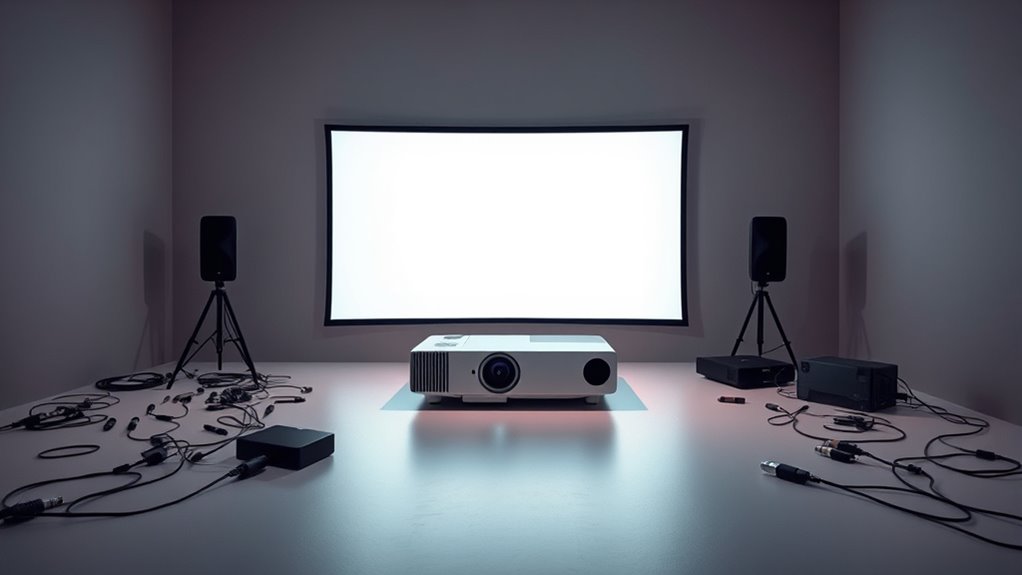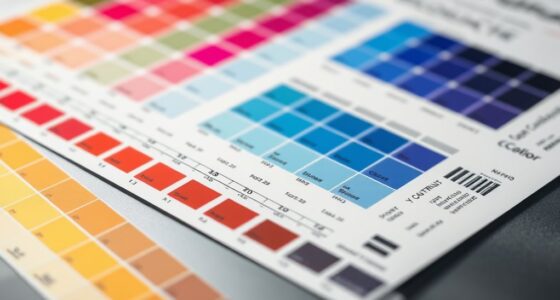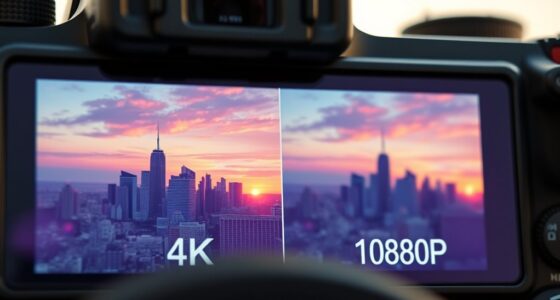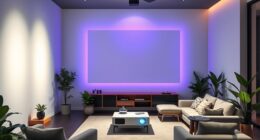Many common projector myths, like thinking higher lumens always mean better images or larger screens automatically improve viewing, are misconceptions. Brightness isn’t the only factor that determines picture quality; your environment and other features like contrast and resolution matter too. Larger screens require compatible projectors to avoid pixelation. If you keep these myths in mind, you’ll make smarter choices. There’s more to uncover about setting up your ideal projector for peak performance.
Key Takeaways
- Higher lumens don’t always mean better image quality; environment and other features matter.
- Larger screens require matching resolution and brightness; size alone doesn’t guarantee clarity.
- Bright lamps may not last longer; higher brightness can shorten bulb lifespan without proper maintenance.
- More features like high specs can be unnecessary without considering your specific space and needs.
- Proper calibration, setup, and compatibility are crucial for optimal projector performance beyond raw specifications.
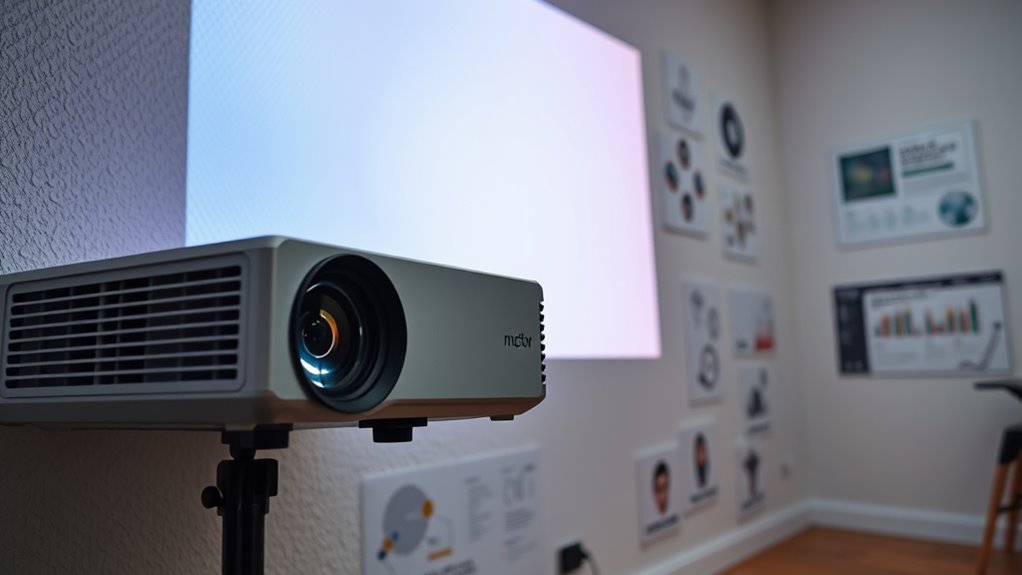
Have you ever believed everything you’ve heard about projectors? It’s easy to get caught up in misconceptions, especially when so much information floating around can be confusing. One common myth is that brighter lamp brightness always equals a better picture. While lamp brightness, measured in lumens, does influence how vivid your projection appears, it’s not the only factor to consider. Many assume that the higher the lumens, the better the projector, but that’s not necessarily true. If you’re projecting in a dark room, you don’t need an ultra-bright model; a lower lumen count can produce a sharp, clear image without washing out. Conversely, in a bright space with lots of ambient light, a projector with higher lamp brightness helps maintain visibility, but even then, other features like contrast ratio and screen quality play essential roles. Simply chasing after more lumens can lead to unnecessary expense and overkill for your specific needs.
Similarly, there’s a misconception that bigger screen size always means better. While larger screens can make viewing more immersive, they also demand a projector capable of delivering a crisp image at that size. If you choose a screen that’s too large for your projector’s resolution and brightness, the picture may become pixelated or blurry, defeating the purpose of having a large display. It’s vital to match your projector’s capabilities to the screen size you want. For example, a projector with a lower resolution or insufficient lamp brightness won’t do justice to an enormous screen, leaving you with a fuzzy or dull image. On the other hand, a projector with a high lumen output and high resolution allows you to project larger images without sacrificing clarity. Remember, size isn’t everything—quality and compatibility matter just as much. Additionally, understanding the importance of proper calibration and placement can significantly enhance your viewing experience.
People also believe that brighter lamps mean longer-lasting bulbs, but that’s a misconception. Brightness and lamp lifespan often have an inverse relationship; higher lumen settings can cause the bulb to burn out faster, especially if used at maximum capacity for extended periods. Proper maintenance, such as running the projector in eco mode or turning it off when not in use, can help extend the life of your lamp regardless of how bright it is.
Understanding these myths helps you make smarter choices when selecting and using a projector. It’s not about chasing the highest specs but finding the right balance of lamp brightness, screen size, resolution, and overall features for your specific environment. When you approach projectors with a clear understanding, you’ll enjoy better visuals and save money in the long run.
Frequently Asked Questions
Can Projectors Be Used Outdoors Effectively?
Yes, you can use projectors outdoors effectively if they have weather resistance features. Look for models designed to withstand moisture, dust, and temperature changes to avoid damage. Keep portability concerns in mind—choose a lightweight, compact projector for easy setup and transport. Using a sturdy, weatherproof screen and an appropriate power source guarantees your outdoor movie nights run smoothly, even in less-than-ideal conditions.
Do High-Lumen Projectors Always Produce Brighter Images?
Like Icarus soaring too close to the sun, you might think higher lumen ratings always mean brighter images. But brightness levels aren’t just about lumens; they also depend on ambient light, screen size, and image quality. A high-lumen projector can still underperform in a bright room if other factors aren’t ideal. So, remember, more lumens don’t always guarantee a brighter picture—consider your environment and needs carefully.
Are 4K Projectors Worth the Investment?
Yes, 4K projectors are worth the investment if you value resolution benefits like sharper images and improved detail, especially for movies or presentations. However, consider your budget and the cost considerations, as 4K models tend to be pricier. If you mainly need basic projections, a lower resolution projector might suit you better. Weigh the visual quality against your budget to make the best choice for your needs.
How Long Do Projector Bulbs Typically Last?
Your projector bulb typically lasts between 1,500 to 3,000 hours—plenty of time to binge-watch, binge-study, or binge-argue with your friends about whether it’s time for replacement. To maximize bulb lifespan, follow replacement tips like keeping the projector cool and avoiding frequent on/off cycles. When it’s dimmer or flickering, you’ll know it’s time to swap out the bulb—because no one wants a surprise ending during your movie night.
Is Screen Size Adjustable With All Projectors?
Not all projectors have adjustable screen sizes due to screen size limitations, but many do feature adjustable lens focus to modify the image clarity and size within certain constraints. If you want a flexible setup, look for projectors with zoom and keystone correction options, as these can help you customize the display size to fit your space. Keep in mind that some models might have more limited adjustment capabilities than others.
Conclusion
Now that you know the truth behind projector myths, you can confidently choose the right one without fear of misconceptions. Instead of being misled by hype or outdated beliefs, you’ll see the clear advantages of modern projectors. It’s like peeling away fog to reveal a bright, crisp picture—you’re ready to make informed decisions and enjoy your viewing experience. Don’t let myths hold you back; embrace the facts and see the difference for yourself.
